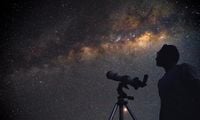As the quest for extraterrestrial life intensifies, scientists are on the brink of potentially groundbreaking discoveries. Recent findings suggest that we may be closer than ever to confirming the existence of life beyond Earth, particularly with the detection of biosignatures on the exoplanet K2-18b, located 124 light years away in the Leo constellation. Using the James Webb Space Telescope (JWST), a British-US research team has identified two chemicals in the planet's atmosphere that are typically produced by life on Earth, specifically by microscopic marine organisms.
Prof. Nikku Madhusudhan, an astrophysicist at Cambridge University and the lead author of the study published in The Astrophysical Journal Letters, stated, "What we are finding at this point are hints of possible biological activity outside the solar system. Frankly, I think this is the closest we have come to seeing a feature that we can attribute to life." The chemicals in question are dimethyl sulfide (DMS) and dimethyl disulfide, both of which are associated with biological processes on our planet.
K2-18b is classified as a hycean planet, meaning it is likely an ocean world capable of hosting microbial life. This exoplanet is more than eight times the mass of Earth and orbits its star every 33 days, placing it within the habitable or "Goldilocks" zone where conditions may be just right for liquid water, an essential ingredient for life as we know it.
Since the first exoplanet was discovered orbiting another star in 1992, astronomers have identified nearly 6,000 additional planets outside our solar system. The JWST, launched in 2021, has been pivotal in these discoveries, successfully capturing the chemical signatures of various compounds in the atmospheres of these distant worlds. In 2023, it detected methane and carbon dioxide in K2-18b's atmosphere, marking the first time such carbon-based molecules were observed in a habitable zone.
Despite the excitement surrounding these findings, skepticism remains among some scientists. Critics caution that the detected chemicals could have non-biological origins. For instance, traces of DMS were previously found on a comet, suggesting that it can also be produced through abiotic processes. Prof. Raymond Pierrehumbert, a planetary physics professor at Oxford University, has raised concerns about the habitability of K2-18b, arguing that the planet may be too hot for life to exist, potentially leading to oceans of lava instead of liquid water.
To confirm the findings, Madhusudhan estimates that an additional 16 to 24 hours of observation time with the JWST will be necessary. He believes that this research could represent a tipping point in humanity's understanding of life beyond our planet. "This could be the tipping point, where suddenly the fundamental question of whether we're alone in the universe is one we're capable of answering," he remarked.
As the scientific community continues to explore the cosmos, researchers are also considering new methods for detecting alien life. Mikhail Tikhonov, a physicist at Washington University in St. Louis, and Akshit Goyal from the International Centre for Theoretical Science in India, have proposed a novel approach that shifts the focus from familiar Earth-like biosignatures to patterns of energy usage. Their research, published in Nature Communications, suggests that the competition between organisms creates measurable patterns that could indicate the presence of life.
Tikhonov emphasizes that current efforts often rely on identifying molecules that are associated with life on Earth, such as oxygen or methane. However, he argues that these substances can also be produced through non-living processes, which could lead scientists to overlook alien life forms that do not resemble those on Earth. Instead, Tikhonov and Goyal propose looking for energy-ordered stratification, a phenomenon where compounds in an environment are layered based on their energy content. This pattern could serve as a universal biosignature, indicating the presence of life regardless of its chemical makeup.
According to Tikhonov, "This pattern doesn’t depend on what the life forms look like. As long as there is self-replication and ecological competition, the same kind of energy-driven layering should appear." This approach allows researchers to look beyond familiar life forms and consider the possibility of entirely different biological systems that may exist elsewhere in the universe.
With ongoing missions planned to explore Mars, the icy moons of Jupiter and Saturn, and even beyond our solar system, the search for extraterrestrial life is more active than ever. The European Space Agency's ExoMars rover is set to launch in 2028 to drill beneath the Martian surface in search of signs of past or present life, while NASA's Dragonfly mission aims to land on Saturn's moon Titan in 2034 to study its unique chemistry.
As scientists push the boundaries of exploration, the implications of discovering life beyond Earth are profound. Prof. Madhusudhan believes that finding even simple life forms would fundamentally alter our understanding of our place in the universe. He asserts, "When we would look at the sky, we would see not just physical objects, stars and planets, we would see a living sky. The societal ramifications of that are immense. It will be a huge transformational change in the way we look at ourselves in the cosmic scene."
As humanity stands on the brink of potentially answering one of its oldest questions—are we alone in the universe?—the excitement and curiosity surrounding these discoveries continue to grow. Whether through the detection of biosignatures on distant planets or the development of new methods for identifying alien life, the journey to uncover the mysteries of the cosmos is just beginning.







